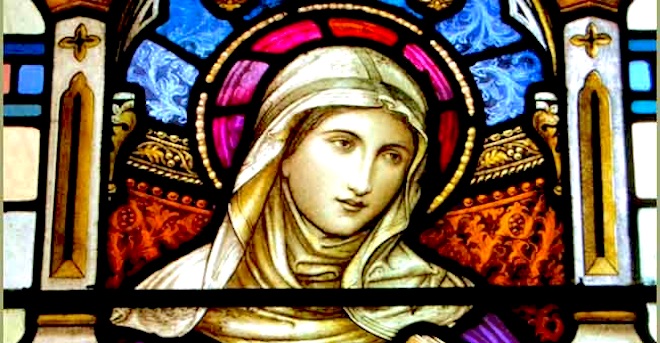The book of questions and the theology of Santa Brigida

The Fifth Book of Revelations, called the Book of Questions, is very particular and completely different from the others: it is the proper theological text of Saint Brigid. It is the result of a long vision that the saint had when she was still living in Sweden and from the monastery of Alvastra, where she had settled after the death of her husband, she was going on horseback to the castle of Vadstena that the king had given her to be the seat of the order of the Most Holy Savior.
The Spanish bishop Alfonso Pecha de Vadaterra, author of the preface to the book, says that Brigida suddenly fell into ecstasy and saw a long staircase that started from the ground and reached the sky where Christ was seated on the throne as a judge, surrounded by angels and saints, with the Virgin at her feet. On the stairs there was a monk, an educated person whom Brigida knew but who is not named; he proved very agitated and nervous and gesticulating stubbornly asked questions to Christ, who answered him patiently.
The questions that the monk asks the Lord are those that probably each of us, at least once in our life, asks about the existence of God and human behavior, in all likelihood the same questions that Brigida herself had asked herself or asked herself. The Book of Questions is therefore a sort of manual of Christian faith for people with unshakeable faith, a very human text and very close to the soul of anyone who seriously and sincerely questions the great problems of life, faith and our ultimate destiny.
We know that, having arrived in Vadstena, Brigida was awakened by her servants; she was sorry, because she would have preferred to remain in the spiritual dimension in which she found herself immersed. But everything had remained perfectly etched in his mind, so he could write it down in no time.
In the monk who climbs the ladder many have seen the master Matthias, the great theologian, Brigida's first confessor; others generically a Dominican friar (in the miniatures of the manuscripts the monk is represented with the Dominican habit), a symbol of intellectual pride to which, however, Jesus, with extreme understanding and generosity, offers all the answers. Here is how the discussion is introduced:
It happened once that Brigida went horseback riding in Vadstena being accompanied by several of her friends, who were also on horseback. And as she rode she raised the spirit to God and was immediately raptured and alienated from the senses in a singular way, suspended in contemplation. He saw then as a ladder fixed to the ground, the top of which touched the sky; and in the heights of heaven he saw Our Lord Jesus Christ seated on a solemn and admirable throne, as a judge of judgment; at her feet was the Virgin Mary and around the throne there was an innumerable company of angels and a large assembly of saints.
Halfway up the ladder he saw a religious who knew and still lived, a connoisseur of theology, an end and a deceiver, full of diabolical malice, who by the expression of his face and manner showed that he was impatient, more devil than religious. She saw the internal thoughts and feelings of that religious's heart and how she expressed herself towards Jesus Christ ... And she saw and heard how Jesus Christ the judge answered these questions sweetly and honestly with brevity and wisdom and how every now and then Our Lady said a few words to Brigida.
But when the saint had conceived the contents of this book in spirit, it happened that she arrived at the castle. Her friends stopped the horse and tried to wake her from her kidnapping and she was sorry that she had been deprived of such great divine sweetness.
This book of questions remained etched in his heart and in his memory as if it had been carved in marble. She immediately wrote it in her vulgar language, which her confessor later translated into Latin, just as she had translated the other books ...
The Book of Questions contains sixteen questions, each of which is divided into four, five or six questions, each of which Jesus answers in detail.